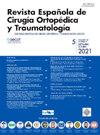[Artículo traducido] Minimización del sangrado y la transfusión en artroplastias bilaterales de cadera y rodilla en un solo tiempo: una revisión sistemática de las intervenciones actuales
Q3 Medicine
Revista Espanola de Cirugia Ortopedica y Traumatologia
Pub Date : 2025-07-14
DOI:10.1016/j.recot.2025.07.015
引用次数: 0
Abstract
Objectives
To evaluate perioperative strategies for minimizing bleeding and transfusion needs in single-stage bilateral hip and knee arthroplasty. This systematic review identifies effective interventions and provides evidence-based recommendations and highlight areas for future research in optimizing bleeding management.
Methods
A systematic review of literature from January 2010 to October 2024 was conducted, focusing on randomized controlled trials, meta-analyses, and guidelines. Databases searched included PubMed/MEDLINE, Embase, Cochrane Library, and Web of Science. Interventions assessed included tranexamic acid (TXA), surgical techniques, regional anesthesia, controlled hypotension, preoperative anemia correction, tourniquet use, bone wax, and restrictive transfusion strategies. Study selection, data extraction, and quality assessment followed PRISMA and Newcastle-Ottawa Scale guidelines.
Results
From 325 included studies, TXA consistently demonstrated the most significant impact, reducing transfusion rates by 40-60%. Anterior total hip arthroplasty was associated with reduced blood loss. Regional anesthesia and controlled hypotension further minimized intraoperative bleeding. Preoperative anemia correction and restrictive transfusion thresholds also showed benefits. Tourniquet evidence was inconclusive. Limited evidence supported bone wax. GRADE assessment suggested high evidence quality for TXA and regional anesthesia, moderate for minimally invasive surgery, anemia correction, and restrictive transfusion, and low for bone wax.
Conclusions
Multimodal approach integrating TXA, regional anesthesia, minimally invasive surgery, anemia correction, and restrictive transfusion protocols effectively reduces bleeding and transfusion needs in bilateral arthroplasty. Incorporation into enhance recovery after surgery protocols is recommended. Future research should refine TXA dosing, clarify tourniquet use, and assess cost-effectiveness.
双侧髋关节和膝关节置换术的一次性出血和输血最小化:对现有干预措施的系统回顾
目的探讨单期双侧髋关节和膝关节置换术中减少出血和输血需求的围手术期策略。本系统综述确定了有效的干预措施,提供了基于证据的建议,并强调了优化出血管理的未来研究领域。方法对2010年1月至2024年10月的文献进行系统回顾,主要包括随机对照试验、荟萃分析和指南。检索的数据库包括PubMed/MEDLINE、Embase、Cochrane Library和Web of Science。评估的干预措施包括氨甲环酸(TXA)、手术技术、区域麻醉、控制低血压、术前贫血矫正、止血带使用、骨蜡和限制性输血策略。研究选择、数据提取和质量评估遵循PRISMA和纽卡斯尔-渥太华量表指南。结果在325项纳入的研究中,TXA始终显示出最显著的影响,可将输血率降低40-60%。前路全髋关节置换术可减少失血量。区域麻醉和控制低血压进一步减少术中出血。术前贫血矫正和限制性输血阈值也显示出益处。止血带证据尚无定论。有限的证据支持骨蜡。GRADE评价表明,TXA和区域麻醉的证据质量高,微创手术、贫血矫正和限制性输血的证据质量中等,骨蜡的证据质量低。结论结合TXA、区域麻醉、微创手术、贫血矫正和限制性输血方案的多模式入路可有效减少双侧关节置换术的出血和输血需求。建议纳入增强术后恢复方案。未来的研究应完善TXA剂量,澄清止血带的使用,并评估成本效益。
本文章由计算机程序翻译,如有差异,请以英文原文为准。
求助全文
约1分钟内获得全文
求助全文
来源期刊

Revista Espanola de Cirugia Ortopedica y Traumatologia
Medicine-Surgery
CiteScore
1.10
自引率
0.00%
发文量
156
审稿时长
51 weeks
期刊介绍:
Es una magnífica revista para acceder a los mejores artículos de investigación en la especialidad y los casos clínicos de mayor interés. Además, es la Publicación Oficial de la Sociedad, y está incluida en prestigiosos índices de referencia en medicina.
 求助内容:
求助内容: 应助结果提醒方式:
应助结果提醒方式:


